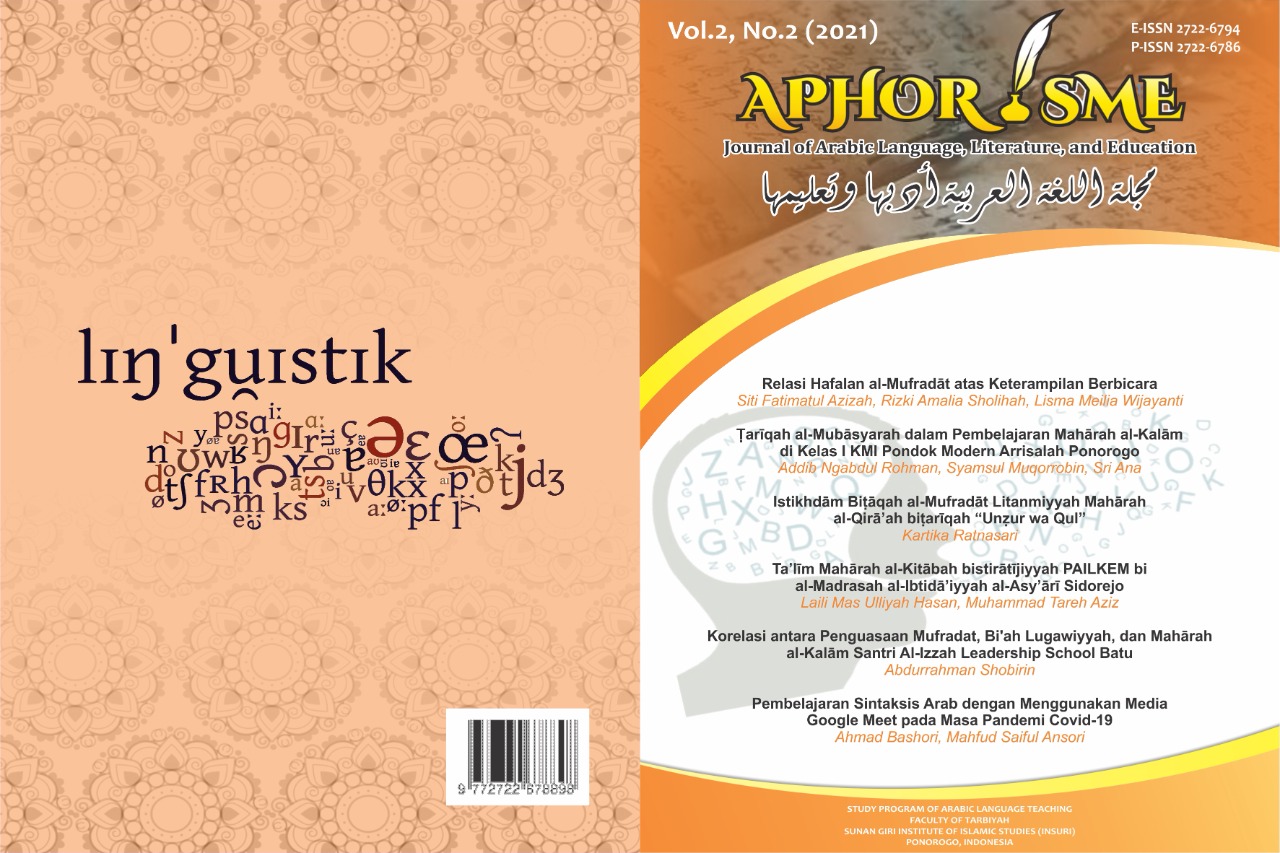Istikhdām Biṭāqah al-Mufradāt Litanmiyyah Mahārah al-Qirā’ah biṭarīqah “Unẓur wa Qul” The Use of Vocabulary Cards to Improve Arabic Reading Skills with the "See and Say" Method Section Articles
##plugins.themes.academic_pro.article.main##
Abstract
Arabic Language learning is now highly improved by Islamic and general schools. Certainly, the way of improvement needs a special method in its teaching to be gained well by the beginner of this study. From the interview done by the researcher, students of the first grade of Junior High School had very low Arabic reading ability so that they need certain teaching methods to equip them with good ability in Arabic reading skills. To overcome this problem, the researcher applied a teaching method by using vocabulary adapted from the “Look and Say” method by considering that this card is one of the media to improve the reading ability of students in the teaching process. This research focused on the effectiveness of vocabulary cards in improving reading ability in makhraj huruf pronunciation, vocabulary meaning mastery, type of sentence understanding, and word context understanding. This research used classroom action research which consists of two cycles in which every cycle has four steps: planning, action, observation, and reflection. The population of this research is the first grade of Junior High School students. The results of this research showed that vocabulary card application can increase their reading ability from their makhraj huruf pronunciation of vocabulary, vocabulary meaning mastery through its picture, sentence type understanding in jumlah ismiyah with ism isyarah, vocabulary context understanding which consists of shifah maushufah.
##plugins.themes.academic_pro.article.details##
References
Aisyah, S. (2019). Improving reading skill through look and say method. SELTICS, 2(2), 99–107.
Akuibuilo, F., Okorie, E. U., Onwuka, G., & Uloh-Bethels, A. C. (2015). Reading Readiness Deficiency in Children: Causes and Ways of Improvement. Journal of Education and Practice, 6(24), 38–43.
Al-Homoud, F. A., & Osman, S. N. (2015). Flash Cards vs. Word Lists for Vocabulary Building among Majmmah High School Students. Journal of Human and Administrative Sciences, 7, 1–19. https://doi.org/10.12816/0024010
Baleghizadeh, S., & Ashoori, A. (2011). The Impact of Two Instructional Techniques on EFL Learners ’ Vocabulary Knowledge. International Journal of Language Learning and Applied Linguistics World, 6(4), 156–167.
Erbey, R., McLaughlin, T. F., Derby, K. M., & Everson, M. (2011). The effects of using flashcards with reading racetrack to teach letter sounds, sight words, and math facts to elementary students with learning disabilities. International Electronic Journal of Elementary Education, 3(3), 213–226.
Indrawan, R. (2021). PENINGKATAN KETERAMPILAN MEMBACA BAHASA ARAB MELALUI TEKNIK LOOK AND SAY ( Penelitian Tindakan Siswa Kelas IV SDIT Segar Amanah ). 20, 216–224.
Kemmis, S., McTaggart, R., & Nixon, R. (2014). The action research planner: Doing critical participatory action research. In The Action Research Planner: Doing Critical Participatory Action Research. https://doi.org/10.1007/978-981-4560-67-2
Komachali, M. E., & Khodareza, M. (2012). The effect of using vocabulary flash card on Iranian pre-university students’ vocabulary knowledge. International Education Studies, 5(3), 134–147. https://doi.org/10.5539/ies.v5n3p134
Lutfiati, R. R., & Wahyuni, F. (2021). Ta’līm al-Lugah al-‘Arabiyyah bimajāl Mahārah al-Qirā’ah wa al-Kitābah. Aphorisme: Journal of Arabic Language, Literature, and Education, 2(1), 33–46.
Masqon, D. (2014). ﻞﻀﻓﺃ ﻞﺒﻘﺘﺴﻣ ﻮﳓ ﺎﻴﺴﻴﻧﻭﺪﻧﺇ ﺀﺎﻨﺑﻷ ﺔﻴﺑﺮﻌﻟﺍ ﺔﻐﻠﻟﺍ ﻢﻴﻠﻌﺗ ﺔﻴﻠﻤﻋ ﻞﻴﻌﻔﺗ ﰲ ﺕﻼ ﻣ ّ ﺄﺗ. Lisanudhad, 13(1), 1–17.
Mukminin, A. (2021). I’dād al-Mawād al-Ta’līmiyyah li Mahārah al-Kalām ‘alā Asās al-Żakā’āt al-Muta’addidah bi al-Madrasah. Aphorisme: Journal of Arabic Language, Literature, and Education, 2(1), 13–22.
Nilam, C. (2021). THE USE OF LOOK SAY METHOD TO IMPROVE STUDENTS.
Salma, K. N. (2020). تطوير مواد مهارة الاستماع باستخدام الوسائل المتعددة برمجة فلوتاغون ستوري لتلاميذ المدرسة المتوسطة الاسلامية الحكومية الثانية مالانج. Universitas Islam Negeri Maulana Malik Ibrahim.
Supriatin, T., & Rizkilillah, V. P. (2018). Teaching Vocabulary Using Flashcard. PROJECT (Professional Journal of English Education), 1(4), 479. https://doi.org/10.22460/project.v1i4.p479-485
Susanti, S., & Asyrofi, S. (2020). Efektivitas Metode Imlā’Manẓūr dalam Meningkatkan Keterampilan Menulis Bahasa Arab Siswa Madrasah Tsanawiyah. Aphorisme: Journal of Arabic Language, Literature, and Education, 1(2), 1–22.
Vega, K. (2002). Methodology in Language Teaching. In Methodology in Language Teaching. https://doi.org/10.1017/cbo9780511667190
Wilkinson, D. (2017). EFL Vocabulary Acquisition through Word Cards: Student Perceptions and Strategies. Tesl-Ej, 21(3), 1–16.
Versteegh, Kees. (2015). An empire of learning: Arabic as a global language. 41-54.

